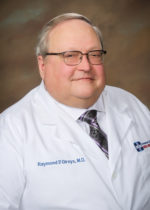Greenwood Leflore Hospital’s team of General Surgeons can diagnose and treat your symptoms in a timely and professional manner.
Their expertise ranges from hernia repairs, appendectomies and gallbladder removal to treatment of breast diseases and removal of skin tumors and masses. Wound care, pacemaker insertion and vascular procedures are just a few of the specialties which Greenwood Leflore Hospital’s surgeons offer to their patients. If your family physician recommends evaluation by a General Surgeon, you can be assured that Dr. John Lucas III and Dr. Raymond Girnys will use the latest in technology and surgical methods to diagnose and correct the problem.
A General Surgeon specializes in operative treatment of pathology involving multiple body systems, including vascular, gastrointestinal, breast, cardiac, pulmonary, endocrine, skin disorders and wound care. General Surgeons often specialize in certain areas of the body or certain types of procedures.
Physicians
Vascular
Vascular access: In patients who must receive frequent medications or fluids delivered directly into the bloodstream, general surgeons can insert a small catheter into the heart through the large blood vessels in the arms or neck and attach the catheter to an easily accessible device that is implanted just under the skin.
Dialysis access: arteriovenous fistula For hemodialysis access, one of the arm veins is attached to a nearby artery, enlarging the vein for high volume blood flow so that blood can be removed from the body, and after waste products are removed and returned to the body.
Carotid Surgery: Stroke prevention surgery removing blockage from inside the artery.
Medication administration access: Port-a-caths for chemo and arteriovenous fistula for dialysis – now created to make needle insertion easier – made to have high volume blood flow.
Aortic Aneurysm repair: The aorta is the largest artery in the body, carrying blood from the heart to the chest, abdomen and lower extremities. If the walls of the aorta become weakened, they can balloon out and even rupture. Vascular surgeons can assess the severity of aortic aneurysms and stenting or repair is the most common method of treatment.
Gastrointestinal
Esophagus, stomach and bowels: A variety of conditions may affect the gastrointestinal system, including bleeding, peptic ulceration, obstruction, perforation, irritable bowel syndrome, diverticulosis and diverticulitis, polyps, appendicitis, hemorrhoids and a variety of cancers. General surgeons can evaluate these diseases in a multitude of ways including detailed history, physical exam to specific diagnostic techniques and testing. Treatment may range from prescriptions and lifestyle changes to laparoscopic investigation to full surgical intervention.
Appendectomy: The appendix is a small, finger-like hollow appendage near the junction of the small and large intestines. If it becomes inflamed or infected, surgical intervention may be necessary to remove it.
Learn more about appendectomies on WebMD.
Hemorrhoids: These are networks of blood vessels located around the anus, both internal and external. If they become enlarged, they may cause pain and rectal bleeding. A general surgeon can evaluate the extent of the hemorrhoids and recommend medical solutions or surgical removal.
Learn more about hemorrhoidectomies on WebMD.
Hernia repair (inguinal or umbilical): A hernia is a defect in the muscular wall of the abdomen or groin area, allowing intestinal tissue to bulge out through the opening. A general surgeon can evaluate the severity of the herniation and usually correct it with a simple procedure.
Learn more about hernia repair on WebMD.
Gallbladder: The gallbladder is a small hollow organ underneath the liver; that stores and releases bile to break down fats in the diet. If stones form within the gallbladder or its ductal system, they may have to be removed. General surgeons can evaluate the health of the gallbladder with ultrasounds, CT scans or endoscopic studies. If gallbladder surgery is necessary, it will usually be done laparoscopically, which involves small incisions on the abdomen and the insertion of an instrument for visualization and excision of the gallbladder and its stones.
Learn more about the gallbladder on WebMD.
Colorectal problems: Pathology in the small intestine, the large intestine or the rectum may cause discomfort, constipation or diarrhea or bleeding. Polyps, cancers, diverticulosis or diverticulitis, irritable bowel syndrome, rectal fissure or fistulas can be visualized and potentially treated through the insertion of a colonoscope or endoscope. If more extensive treatment is necessary, laparoscopic or open abdominal surgery may be necessary.
Liver: The liver is a large, complicated organ located just beneath the right rib cage. Its purpose is to detoxify many substances in the body that we eat or drink. It can be involved in a variety of pathologic conditions, and general surgeons are able to determine the appropriate way to make the diagnosis.
Endoscopy: General surgeons utilize a variety of lighted, flexible scopes to visualize the upper and lower gastrointestinal systems for diagnosis, biopsy and treatment of many diseases.
Breast
Biopsy: Physical examination or mammography may discover breast lumps which require further work-up. General surgeons can obtain tissue for pathologic examination with needle aspiration or stereotactic (x-ray guided) biopsy procedures. In some cases, an open biopsy is necessary. Not all lumps are cancerous. Frequent doctor visits and breast self-examinations are very important. Feeling something different should prompt a referral to a surgeon to see if further workup is necessary.
Minimally invasive biopsy procedures:
- Core Needle Biopsy: A hollow needle is used to withdraw small cylinders (or cores) of tissue from the suspicious area in the breast. CNB with local anesthesia (you are awake but your breast is numbed). CNB can cause some bruising, but usually does not leave scars inside or outside the breast.
- Sentinel Node Biopsy: Sampling the lymph nodes in the arm pit that drains the breast, an axillary lymph node dissection may be needed if cancer is found in the lymph nodes.
- Stereotactic Biopsy: A stereotactic core needle biopsy uses x-ray equipment and a computer to analyze the pictures (x-ray views). The computer then pinpoints exactly where in the abnormal area the needle tip needs to go. This is often done to biopsy suspicious micro calcifications (tiny calcium deposits) when no mass can be felt or seen on ultrasound.
- Ultrasound guided vacuum assist biopsy: A small incision is made where a hollow probe is inserted and guided into the abnormal area of the breast tissue using ultrasound. A cylinder of tissue is then pulled into the probe through a hole in its side, so that a sample of tissue is removed from the breast.
Learn more about breast biopsy on komen.org.
Cancer surgery (lumpectomy and mastectomy): If breast cancer is diagnosed, the surgeon may remove just the affected area (lumpectomy) or a more extensive procedure, called simple or radical mastectomy.
Learn more about lumpectomy on mayoclinic.com.
Learn more about mastectomy on mayoclinic.com.
Oncoplasty procedures: A surgical procedure utilizing breast reduction techniques to remove the cancer and excess breast tissue allowing for improved cosmetic results and less scarring. Usually requires additional radiation therapy to the breast after surgery.
Reconstructive surgery: Following a mastectomy, various procedures may be performed to recreate the breast shape and restore the anatomy as much as possible. Implants, expanders and tissue flaps are all possibilities in the postmastectomy patient.
Reduction: Some patients may require elimination of excess breast tissue, which can be evaluated and performed by a general surgeon.
Cardiac
Pacemaker insertion: Irregularities of the heart’s electrical system can often be treated with medication. If this is not successful, a surgeon can implant a cardiac pacemaker underneath the chest wall to help override irregular rhythms.
Pulmonary
Bronchoscopy: When lesions in the respiratory tract (pharynx, larynx, trachea, bronchi and bronchioles) are seen on radiologic imaging studies, it may be necessary for a pulmonologist to insert a thin, flexible scope through the mouth and down to the lungs. Biopsies can be done through this scope to help in diagnosis.
Endocrine
Thyroid: The thyroid gland is located in the front of the neck; it serves several functions in regulating the body’s metabolism. When the thyroid malfunctions, it may require a surgeon to biopsy or remove all or part of the affected area.
Parathyroid: Parathyroid glands are small glands of the endocrine system which are located in the neck behind the thyroid. Hyperparathyroidism is the principle disease of parathyroid glands generally occurring when one of the parathyroids develops a tumor. This tumor is removed by a surgeon through an incision in the neck.
Skin
Biopsy: General surgeons can biopsy skin lesions to check for cancerous growths, removing the entire lesion if necessary. They can also remove lesions for cosmetic purposes.
Learn more about skin biopsy on medlineplus.gov.
Grafts: Skin grafts involve the harvesting of skin from one region of the body to assist in healing in a damaged area, such as after burns or reconstructive surgery.
Wound Care
Wound Care: Following trauma or diseases such as diabetes, peripheral arterial disease, and chronic venous problems, wounds may not heal quickly or properly. General surgeons are trained in the care of such lesions, from prevention of infection to improving blood flow to the affected area. In extreme cases, skin grafts or amputations of affected limbs might need to be performed.
Wound: Any condition or injury causing a break in the skin. Allows bacteria and debris to enter the protective layer into the body.
Types of Wounds:
- Pressure Ulcers are also known as decubitus ulcers, bedsores and pressure sores. They range from simple tenderness and redness to open, necrotic foul swelling areas that need surgical debridement. Cleaning a wound such as this can be life threatening and a surgeon is needed to determine the proper treatment.
- Venous Ulcers are very common in one third of the US population causing swelling and discoloration around the ankle. The can lead to open weeping painful sores that won’t heal without evaluation and treatment by a surgeon. Treatment can be as simple as using moisturizer and support hose and as complex as surgery or grafting. Easily confused with arterial ulcers, treatments are very different and a surgeon is needed to determine which treatment is needed.
- Diabetic Foot Ulcers are usually due to long standing poorly controlled diabetes management which causes poor circulation and neuropathy, which is the inability to feel pain. Prevention, surveillance and good foot care by a skilled podiatrist or surgeon are the key.
Atherosclerotic Peripheral Vascular Disease is due to poor circulation from any cause. Blood can’t get to the site of injury to fight infection and help it to heal many times combined with other types of wounds. These wounds are complex and require the attention of a surgeon.
Traumatic Wounds include cuts, bruises, burns, and surgery. Various types of injuries need various types and duration of treatment. Only a surgical specialist can help solve the middle.
Atypical Wounds: Many rare diseases can exhibit themselves in spots far removed from their origin; most common with malignancies or auto immune disease.
Hyperbaric Oxygen Treatment (HBOT): Specialized chambers where high concentrations of oxygen are forced under high pressure into your tissues in an attempt to help you heal. These specialized chambers are available at the Wound Care Center at Greenwood Leflore Hospital.


